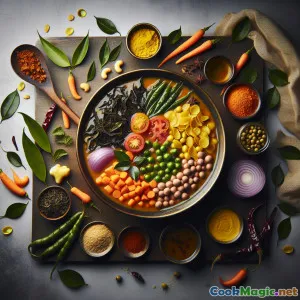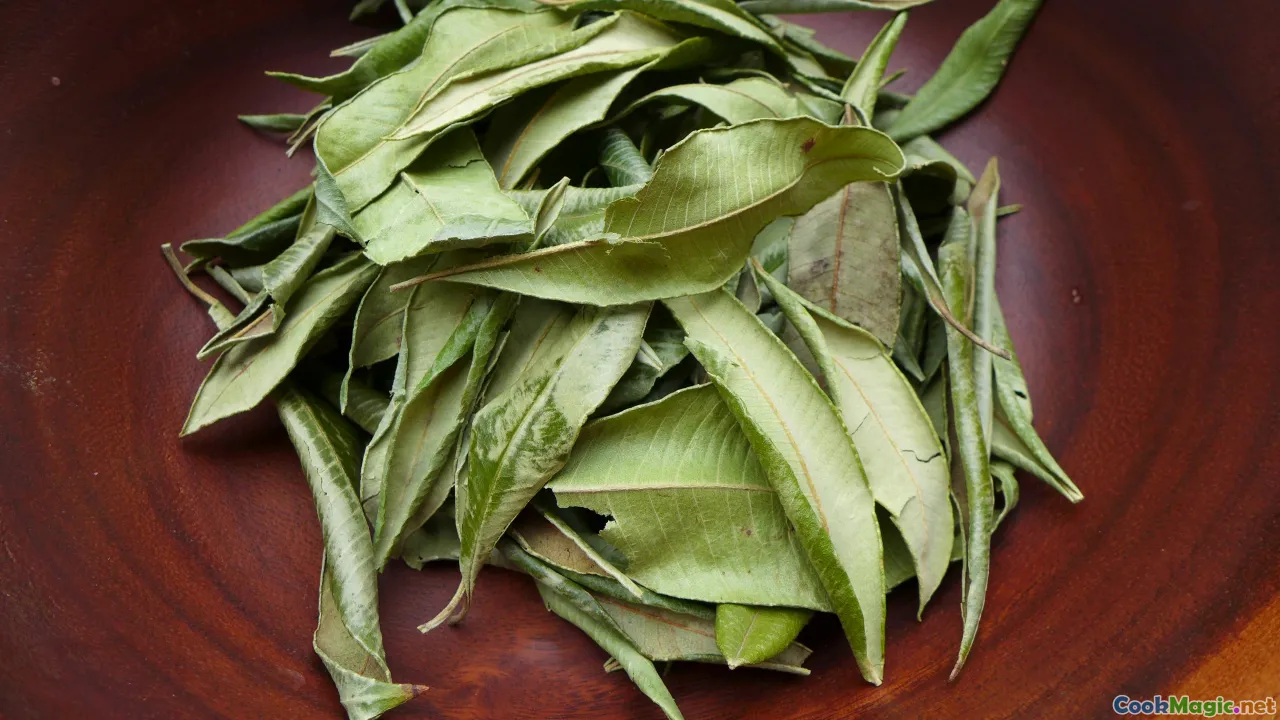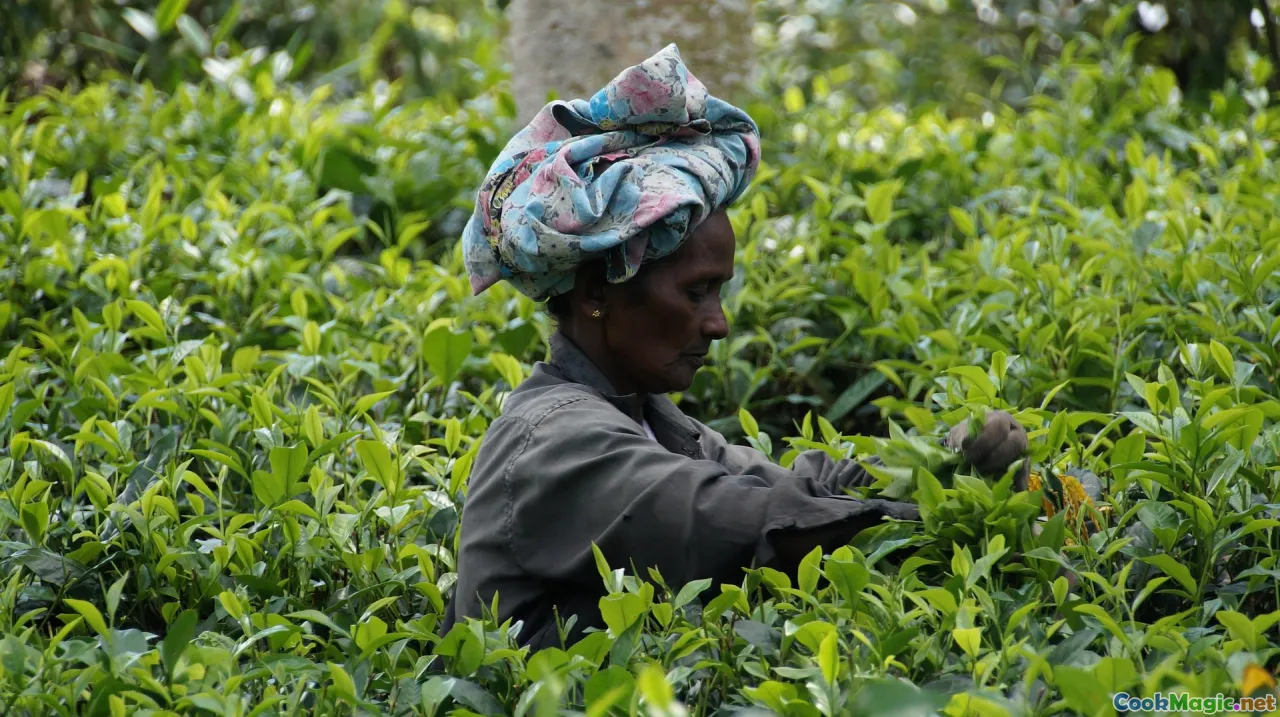
Sambar aux Feuilles de Thé : Une Délicieuse Fusion du Sri Lanka !
(Tea Leaf Sambar: A Sri Lankan Fusion Delight!)
(0 Avis)0
1,142
août 20, 2025
Signaler un problème
Ingrédients
-
150 grams Pois chiches jaunes cassés (Toor dal)
(Washed thoroughly)
-
30 grams Feuilles de thé jeunes de Nuwara Eliya
(Select tender leaves; avoid mature or dried leaves)
-
900 ml Eau
(More for adjusting consistency)
-
1 medium Carotte
(Cut into 2 cm batons)
-
1 whole Gombos de Moringa
(Chopped in 4 cm pieces, can substitute with green beans)
-
1 large Tomate
(En dés)
-
1 medium Oignon
(Tranché finement)
-
2 whole Piment vert
(Fendre dans le sens de la longueur)
-
1.5 tablespoons Pulpe de tamarin
(Soaked and strained for purity)
-
0.25 teaspoons Poudre de Curcuma
-
2 tablespoons Poudre de Sambar
(Any good South Indian blend)
-
1 teaspoon Graines de moutarde
-
10 whole Feuilles de curry
(Frais préféré)
-
2 whole Piment rouge séché
(Coupé en deux)
-
1 pinch Asafoetida
(Hing)
-
2 tablespoons Huile de coco
Sel, to taste
-
1 handful Feuilles de coriandre
(Haché, pour garnir)
(Washed thoroughly)
(Select tender leaves; avoid mature or dried leaves)
(More for adjusting consistency)
(Cut into 2 cm batons)
(Chopped in 4 cm pieces, can substitute with green beans)
(En dés)
(Tranché finement)
(Fendre dans le sens de la longueur)
(Soaked and strained for purity)
(Any good South Indian blend)
(Frais préféré)
(Coupé en deux)
(Hing)
(Haché, pour garnir)
Nutrition
- Portions: 4
- Taille de portion: 1 bol (250g)
- Calories: 210 kcal
- Carbohydrates: 30 g
- Protein: 9 g
- Fat: 6 g
- Fiber: 8 g
- Sugar: 8 g
- Sodium: 650 mg
- Cholesterol: 0 mg
- Calcium: 129 mg
- Iron: 3.4 mg
Instructions
-
1 - Prep Dal and Vegetables:
Wash and soak pigeon peas for 10 minutes. Slice carrot, onion, and tomato. Rinse the tea leaves, drumstick, and chilis.
-
2 - Pressure Cook Lentils:
Add soaked pigeons peas to a pressure cooker with turmeric and 450 ml water. Cook to 4-5 whistles or until completely soft. Mash and set aside.
-
3 - Cook Vegetables and Tea Leaves:
In a large pot, add carrots, drumstick, onion, green chili, tomato, tea leaves and the remaining water. Cook covered for 7–8 minutes until veggies soften and tea leaves wilt.
-
4 - Add Dal, Tamarind, and Spices:
Stir in sambar powder, tamarind pulp, asafoetida, mashed dal, a sprinkle of salt, and simmer another 8 minutes, adjusting water for desired consistency.
-
5 - Temper Sambar (Tadka):
Heat coconut oil in a small pan. Add mustard seeds; let them crackle. Toss in curry leaves and broken red chili, sauté briefly, and pour this tempering over the simmered sambar.
-
6 - Garnish and Serve:
Finish with chopped coriander leaves. Serve hot with steamed rice, idli, or dosa.
Wash and soak pigeon peas for 10 minutes. Slice carrot, onion, and tomato. Rinse the tea leaves, drumstick, and chilis.
Add soaked pigeons peas to a pressure cooker with turmeric and 450 ml water. Cook to 4-5 whistles or until completely soft. Mash and set aside.
In a large pot, add carrots, drumstick, onion, green chili, tomato, tea leaves and the remaining water. Cook covered for 7–8 minutes until veggies soften and tea leaves wilt.
Stir in sambar powder, tamarind pulp, asafoetida, mashed dal, a sprinkle of salt, and simmer another 8 minutes, adjusting water for desired consistency.
Heat coconut oil in a small pan. Add mustard seeds; let them crackle. Toss in curry leaves and broken red chili, sauté briefly, and pour this tempering over the simmered sambar.
Finish with chopped coriander leaves. Serve hot with steamed rice, idli, or dosa.
En savoir plus sur: Sambar aux Feuilles de Thé : Une Délicieuse Fusion du Sri Lanka !
Nuwara Eliya Tea Leaf Sambar: A Sri Lankan Botanical Symphony
Sambar—familiar to many as a soul-warming, protein-packed lentil stew from South India—earned its gastronomic global passport through endless adaptations across Southern Asia. While its base rarely changes (creamy lentils, tangy tamarind, market-fresh vegetables), regional improvisations are the norm; each cook weaves wisdom and locale into every bubbling pot. Few, however, push the borders of possibility like this unique fusion: Nuwara Eliya Tea Leaf Sambar.
The History and Inspiration Behind the Recipe
This imaginative sambar re-imagines two iconic South Asian emblems. Deep in Sri Lanka’s misty highlands, the rolling fields of Nuwara Eliya are famed for delicate, aromatic tea leaves. Meanwhile, neighbor India boasts a sambar legacy enriched by generations. The idea to weave fresh, young tea leaves with the classic sambar formula emerged while traveling through Nuwara Eliya, where verdant estates beckon culinary experimentation.
Local tradition occasionally utilizes fresh tea leaves for stir fries or herbal broths. Inspired, this recipe integrates tender, plucked tea into sambar not for the usual high-octane tannins or the bitterness of dried black tea, but for grassy, green notes that accent vegetables, the tang of tamarind, and layers of south Indian spice and coconutty aroma from the tempering.
What Makes This Sambar Unique?
The heart is still hearty: yellow split pigeon peas (toor dal) boiled till tender are the generous, nourishing foundation. Robust vegetables (think carrot and drumstick, open to seasonal subs), onions, ripe tomatoes, chilis for warmth, and the all-important sambar powder set things in rhythmic motion. But it’s the plucking and handling of young Nuwara Eliya tea leaves—delicate and vibrantly green—that define the dish. Their addition, cooked lightly to retain faint floral aroma and a suggestion of bitterness, sets a dynamic contrast in both color and flavor.
No less essential is the Tadkā (tempered spices): coconut oil, crackled mustard, hot curry leaves, and bold dried red chili, climaxing in sambar’s signature herbal perfume and gleaming finish.
Tips, Notes, and Variations
- Tea Leaf Choice: Always use youthful, unfermented, preferably bud-tip tea leaves. Older leaves can impart great bitterness.
- Vegetable Flexibility: Off-season, swap drumsticks with okra, potatoes, pumpkin, or courgette.
- Make It a Meal: Sambar, though traditionally a supporting partner to idli, dosa, or rice, can be transformed into a complete bowl—and it’s vegan, gluten-free, and nutritionally dense.
- Spice Levels: Adjust sambar powder (buy or make your own) for more subtlety or depth.
- Texture Variation: For creamier results, mash the dal further; for rustic charm, leave some split peas whole.
- Serve Immediately: The aromas and bright flavor are best right after tempering, lest the tea leaves over-steep.
Origins: History & Cultural Influence
Sri Lanka’s “Teardrop of India” nickname isn’t merely geographic; spice, tamarind, dhal together bind multitudes across the Gulf of Mannar. Indian laborers settling the tea fields centuries ago carried sambar as a daily comfort, but in contemporary kitchens, these worlds combine. Remarkably, tea’s journey—as beverage and now as a leafy green—invites us all to re-think our idea of both.
Sri Lankan foodways are locally abundance-driven. The presence of leafy spinach, jackfruit, or gotukola in curries aren’t arrangements of necessity so much as Creole-style resourcefulness and pleasure. By lending tea leaves to a traditional Indian stew, this sambar admits a chapter in the delicious global tale written by migrants and adventurers.
Serving & Pairing
This garden-bright sambar deserves center stage. Enjoy it steaming, spooned over local rice; with idli for breakfast; or sip on its own as minimalist but luxurious fare—preferably overlooking breezy tea hills.
Personal Thoughts
This recipe encourages cooks to rethink ingredients as possibilities, not boundaries. Nuwara Eliya Tea Leaf Sambar blends artistry, adaptation, tradition, and place. Its subtle bitterness, fresh bite, and gentle vegetal edge celebrate an adventurous spirit—an edible postcard from two great cuisines calling out to cross culinary frontiers.



















